
Banana bunchy top virus
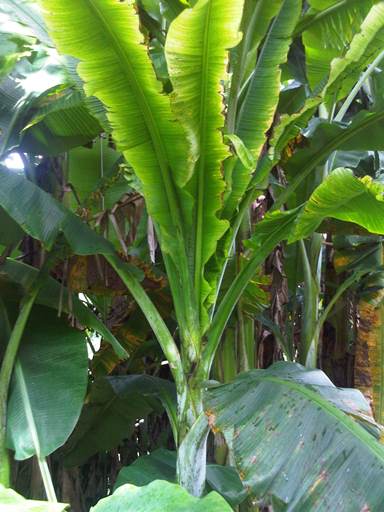
Banana plant showing typical symptoms of banana bunchy top (Image: David Peasley, Manager, National Banana Bunchy Top Project)
Bunchy top disease, caused by the banana bunchy top virus (BBTV), is the most devastating viral disease of bananas worldwide. BBTV is spread by the banana aphid, and both are regulated pests which are being actively controlled in NSW via the Biosecurity (Banana Bunchy Top Virus) Control Order 2021 which came into effect on 1 October 2021.
The department has been working with the Australian Banana Growers Council (ABGC) and the National Banana Bunchy Top Project in the development of this Control Order to better manage BBTV in NSW and continue to support the banana industry.
BBTV Control Order
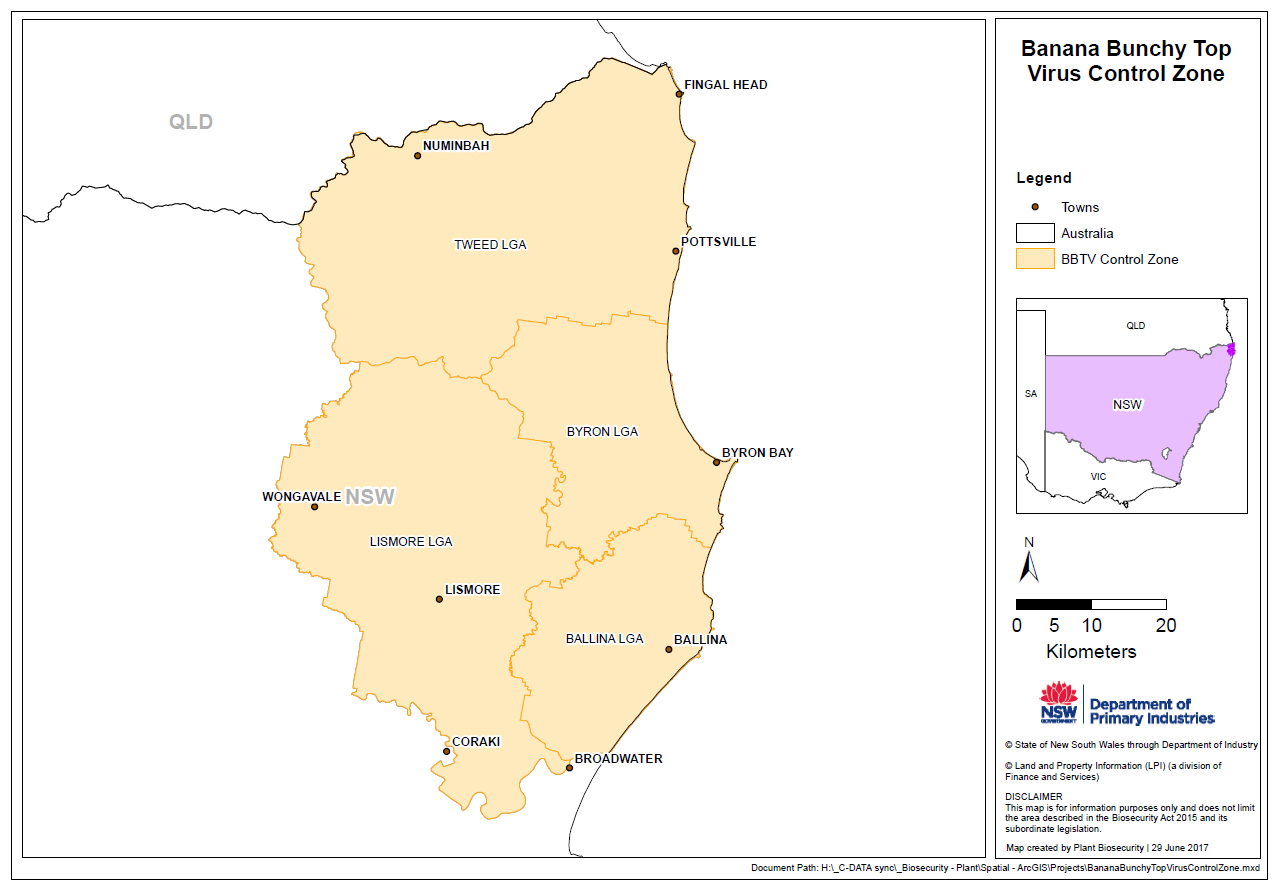 BBTV is present in NSW but confined within the Banana Bunchy Top Virus Control Zone (BBTV Control Zone). The BBTV Control Zone includes the Local Government Areas of Tweed, Lismore, Ballina and Byron Bay.
BBTV is present in NSW but confined within the Banana Bunchy Top Virus Control Zone (BBTV Control Zone). The BBTV Control Zone includes the Local Government Areas of Tweed, Lismore, Ballina and Byron Bay.
In order to minimise the impact of the virus within the BBTV Control Zone and stop the spread outside this zone the BBTV Control Order includes a number of control measures which must be met. Below is a summary of what you need to do to meet these control measures. For full details of the control measures see: Biosecurity (Banana Bunchy Top Virus) Control Order 2021
Control Measures (What do you need to do if you have a banana plant)
Notification of a BBTV infected plant
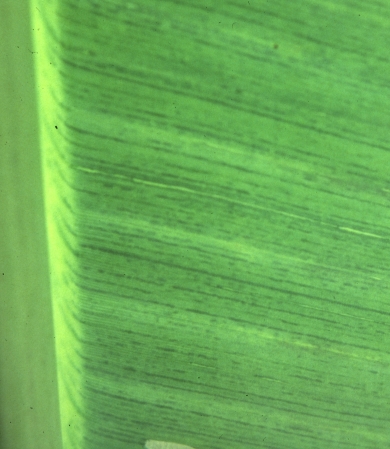
Close up of banana leaf showing dark green leaf streaks which form J hooks at the midrib, typical of banana bunchy top (Image: David Peasley, Manager, National Banana Bunchy Top Project)
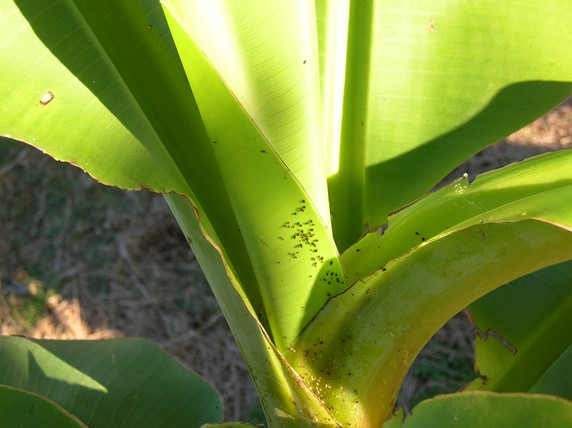
Banana aphids in the throat of a banana plant (Image: David Peasley, Manager, National Banana Bunchy Top Project)
If you become aware of or suspect BBTV, you must notify an authorised officer under the Biosecurity Act 2015, within one business day giving an exact location of the premises. You can do this by calling the Biosecurity Hotline on 1800 680 244 or by sending an email with good quality photographs to quarantine@dpi.nsw.gov.au
If you need help verifying whether you have BBTV, please contact the AGBC BBTV Hotline on 1800 068 371 or go to abgc.org.au/banana-bunchy-top for further information.
Destroying infected plants (and aphids)
If you have any BBTV infected banana plants you must first destroy all banana aphids infecting those plants and then destroy the plants within three days of the detection.
If you need advice or training on how to destroy infected plants and associated banana aphids please contact the AGBC BBTV Hotline on 1800 068 371 or go to abgc.org.au/banana-bunchy-top for further information.
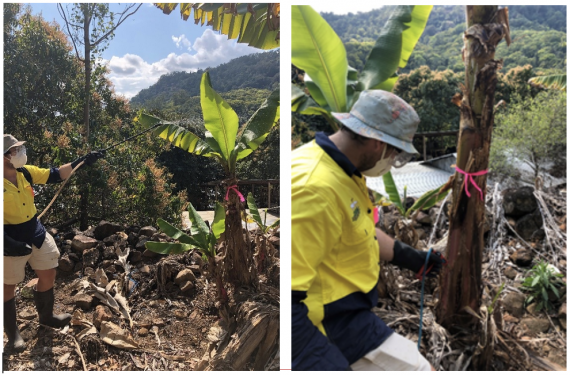
Moving plants and the BBTV Control Zone
Banana plants can be moved into or within the BBTV Control Zone if:
- sourced from anywhere in NSW, including within the BBTV zone if the General Biosecurity Duty is discharged, or
- sourced from interstate provided they are Quality Banana Approved Nursery (QBAN) tissue culture plantlets.
Moving banana plants out of the BBTV Control Zone is prohibited. However you may move the fruit out of the zone.
When banana plants are planted within the BBTV Control Zone, a record of planting form must be completed and returned no later than seven days after planting.
How to discharge your general biosecurity duty when moving banana plants
Actions to minimise risk and discharge your General Biosecurity Duty include:
- source propagation material of a known high health status from reputable suppliers
- monitor your crop regularly
- keep records
- isolate banana plants or areas with suspect symptoms to prevent further spread.
Further advice for sourcing and planting of banana plants can be found in the Banana Industry Biosecurity Code of Practice at abgc.org.au/biosecurity
Weed control around banana plants
The ground within one metre of a banana plant must be kept free of all vegetation higher than 30 cm.
Further information on BBTV
Description
Banana leaves infected with BBTV have dark green streaks along the small veins on the underside of the leaf. The streaks consist of dots and dashes in a Morse code pattern which form J-shaped hooks where they join the midrib.
As BBTV progresses dark green streaks appear on the infected leaves, midribs and stalks. In older banana plants dark green streaks may be seen on flower bracts.
Banana plants which are mature when infected with BBTV may produce fruit but the bunches will be stunted and deformed.
Damage
Banana plants infected with BBTV rarely produce fruit. If fruit is produced it is small, deformed and unmarketable.
Hosts
BBTV infects cultivated and wild bananas in the Musaceae plant family.
Spread
BBTV is transmitted from plant-to-plant by the banana aphid (Pentalonia nigronervosa).
Long distance spread occurs through the movement of infected planting material.
Banana aphid
The banana aphid (Pentalonia nigronervosa) acquires the virus while feeding on the sap of infected plants. The virus can persist in the banana aphid for 13-20 days.
Banana aphids are small with reddish-brown, oval-shaped bodies. They have two characteristic projections at the rear of the abdomen.
Banana aphids may be found:
- in the topsoil at the base of banana plants
- underneath old banana leaves
- on the unfurled leaves of young banana plants and suckers
- beneath outer banana leaf sheaths
- at the throat of the banana plant
BBTV is not transmitted from adult aphids to their offspring. Banana aphids must feed on an infected banana plant to acquire and spread the virus.
Distribution
BBTV is widespread in Southeast Asia, the Philippines, Taiwan, most South Pacific islands, Hawaii, parts of India and Africa.
The banana exporting countries of Latin America and the Caribbean region are free of BBTV.
Australian distribution
BBTV occurs in some areas of south-east Queensland south of Cooloolabin and in the New South Wales Local Government Areas of Tweed, Lismore, Ballina and Byron Bay.
BBTV does not occur in the Coffs Harbour area of New South Wales.
Q&A:
What is the Biosecurity (Banana Bunchy Top Virus) Control Order 2021?
The Biosecurity (Banana Bunchy Top Virus) Control Order 2021 is a set of requirements and measures that have been put in place to help prevent and manage the biosecurity risk posed by the spread of banana bunchy top virus (BBTV) in NSW. It replaces a previous Order, with some amendments.
What has changed?
Moving plants within the Control Zone is now allowed if the General Biosecurity Duty is discharged. This gives greater flexibility for sourcing planting material.
Notification of planting is still required but notification of movement of plants is no longer required.
The timeframe for notification for planting has changed from six months prior to planting to no later than seven days after planting.
Who do these measures apply to?
These control measures apply to anyone:
- who owns, occupies or oversees premises on which banana plants are grown
- who has a banana plant in the BBTV Control Zone
- who knows or ought to know that a banana plant is infected with BBTV
How do I know if I have BBTV?
Typical symptoms of BBTV are often difficult to diagnose so please contact the ABGC BBTV Hotline on 1800 068 371 or abgc.org.au/banana-bunchy-top for further information. Typical symptoms of BBTV are shown in the photos above.
How soon after I suspect my plants have BBTV, do I have to report?
In accordance with the Control Order, the presence or suspected presence of BBTV must be notified within one working day.
How do I notify the Department if I have BBTV?
You can report suspect symptoms by calling the Biosecurity Hotline on 1800 680 244 or by sending an email with good quality photographs to biosecurity@dpi.nsw.gov.au
What if the presence of BBTV infected plants on my property has already been reported to the Department by someone else?
If another party, such as a member of the National BBTV Program, has already reported the presence of BBTV on your property then you do not also need to notify the Department.
If the Department has already been notified of BBTV infected plants on my property, do I need to notify if there are additional plants with BBTV found?
If you are currently working at destroying BBTV infected plants and associated banana aphids on your property and find another infected plant, then you do not need to notify the Department. However, if your plantation has been free of BBTV for some time, after an old detection and notification to the Department, and you find BBTV again on your property then you need to notify the Department.
How do I source healthy planting material?
Advice on how to source healthy planting material can be found in the Banana Industry Biosecurity Code of Practice at abgc.org.au/biosecurity
Can I move bananas out of the Control Zone?
Yes, you can move banana fruit out of the zone, but not banana plants.
Why do I need to destroy the banana aphids on infected plants before I destroy the plants?
The banana aphids on infected plants may carry BBTV and will fly away to other plants if the infected plant they are on is destroyed. Destroying the aphids first reduces the risk of heathy plants becoming infected with BBTV.
How do I destroy the banana aphids and infected banana plants?
Advice on destroying the banana aphids and associated BBTV infected banana plants can be found by contacting the National Banana Bunchy Top Program through the AGBC BBTV Hotline on 1800 068 371 or go to abgc.org.au/banana-bunchy-top.

